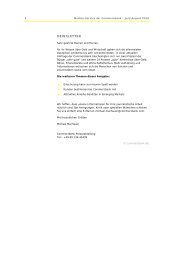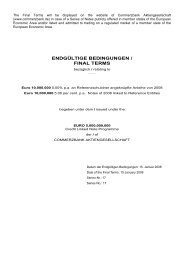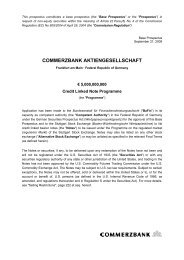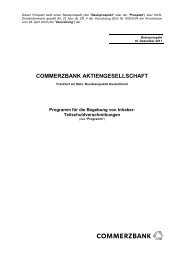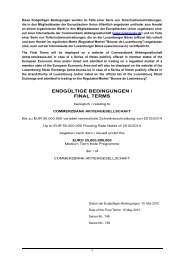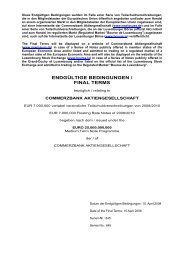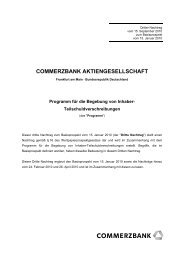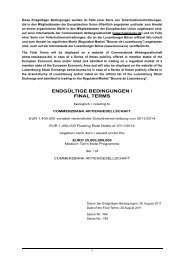COMMERZBANK AKTIENGESELLSCHAFT
COMMERZBANK AKTIENGESELLSCHAFT
COMMERZBANK AKTIENGESELLSCHAFT
Create successful ePaper yourself
Turn your PDF publications into a flip-book with our unique Google optimized e-Paper software.
Group Financial Statements<br />
274<br />
218 Commerzbank Annual Report 2011<br />
These potential replacement costs must be factored in<br />
when determining the fair value of trading positions.<br />
Commerzbank establishes Counterparty Default<br />
Adjustments (CDAs) for these positions, which reflect the<br />
expected loss from any potential counterparty default.<br />
Gains or losses on measurement or disposal are<br />
recorded under net trading income in the income<br />
statement. In addition to realised and unrealised gains<br />
and losses, net trading income also includes the interest<br />
and dividend income and funding costs related to trading<br />
positions.<br />
– Financial instruments designated at fair value through<br />
profit or loss:<br />
Under the fair value option it is permissible to voluntarily<br />
measure any financial instrument at fair value and to<br />
recognise the net result of this valuation in the income<br />
statement. The decision as to whether or not to use the<br />
fair value option must be made upon acquisition of the<br />
financial instrument and is irrevocable. The fair value<br />
option may be applied to a financial instrument provided<br />
that:<br />
– an accounting mismatch will be prevented or<br />
significantly reduced; or<br />
– a portfolio of financial instruments is managed, and its<br />
performance measured, on a fair value basis; or<br />
– the financial instrument has one or more embedded<br />
derivatives that must be separated.<br />
Financial instruments for which the fair value option is<br />
employed are shown in the appropriate balance sheet item<br />
for their respective category. Gains and losses on<br />
remeasurement are recognised in profit or loss under net<br />
trading income, while interest income and expenses are<br />
reported in net interest income. Further details on how<br />
and to what extent the fair value option is used in the<br />
Commerzbank Group can be found in Note 82.<br />
• Available-for-sale financial assets:<br />
This category comprises all non-derivative financial assets<br />
not assignable to one of the above categories or which have<br />
been designated as available-for-sale. Primarily, these are<br />
interest-bearing securities, equities and equity holdings.<br />
They are measured at fair value. If the fair value cannot be<br />
established on an active market, items are measured by<br />
means of comparable prices, indicative prices of pricing<br />
service providers or other banks (lead managers) or internal<br />
valuation models (net present value or option pricing<br />
models). If in exceptional cases the fair value of equity<br />
instruments cannot be reliably determined, measurement is<br />
at amortised cost less any impairments required. Gains and<br />
losses on remeasurement are shown net of deferred taxes in<br />
equity in a separate item within other reserves (revaluation<br />
reserve). Premiums and discounts on debt instruments are<br />
recognised in profit or loss under net interest income over<br />
the life of the instrument. Interest income, dividends and<br />
current profits and losses from equity holdings classified in<br />
this category are also reported under net interest income. If<br />
the financial asset is sold, the cumulative measurement gain<br />
or loss previously recognised in the revaluation reserve is<br />
reversed and taken to profit or loss.<br />
In accordance with IAS 39.59 financial instruments in this<br />
category must be monitored for any objective indications of a<br />
loss (such as breach of contract, loss event, increased<br />
likelihood of bankruptcy proceedings or insolvency) incurred<br />
after the date of initial recognition that would lead to a<br />
reduction in the cash flow arising from them. An impairment<br />
exists when the net present value of the expected cash flows<br />
is lower than the carrying value of the financial instrument<br />
concerned. In the event of an impairment, the net change on<br />
remeasurement is no longer recognised in the revaluation<br />
reserve in equity but must be taken through the income<br />
statement under net investment income as an impairment<br />
charge.



